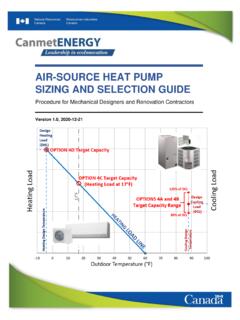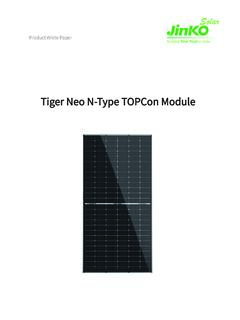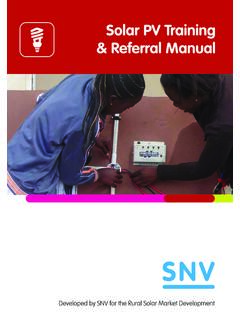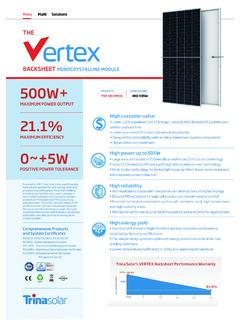Transcription of Planning and Decision Guide for Solar PV systems
1 Planning & Decision Guide FOR Solar PV SYSTEMSP rocedure for Solar Designers, Builders and their Design Teams to Quickly Define Solar PV Requirements Acknowledgements:British Columbia builders used LEEP to identify common PV knowledge gaps and challenge experts to propose solutions. The resulting series of presentations were delivered at LEEP Technology Forums and then through webinars provided by the Canadian Home Builders Associations (CHBA). These presentations were the impetus for the development of this Guide . It was built from a foundation that also includes NRCan s existing Photovoltaic Ready Guidelines. NRCan thanks all those that contributed to the review or trial of the Guide including: Bfreehomes, Bluewater Energy, Building Knowledge, the Net Zero staff at CHBA, Doug Tarry Homes, and Switch Energy. This Guide was developed by Ben Giudici of Riverside Energy systems and Terry Strack of Strack and Associates. Its development was managed by Alastair Larwill from the LEEP team at CanmetENERGY.
2 Funding for this work was provided by Natural Resources Canada through the Green Infrastructure Program. Front cover image: Solar photovoltaic array consisting of polycrystalline-cell modules. Photograph courtesy of Riverside Energy systems . Disclaimer: The aim of this publication is to provide Solar consultants, home owners, home builders and their design and construction teams with a framework for making decisions together on the types of photovoltaic systems to use in residential building projects. Natural Resources Canada assumes no liability for injury, property damage, or loss from using information contained in this publication. This Guide is distributed for informational purposes only and does not reflect the views of the Government of Canada nor constitute an endorsement of any commercial product or person. Cat. No. M154-135/2020E-PDF ISBN: 978-0-660-35861-1 Aussi disponible en fran ais sous le titre: Guide DE PLANIFICATION ET DE D CISION POUR LE CHOIX DES SYST MES DE PANNEAUX SOLAIRES PVContents Natural Resources Canada Planning and Decision Guide for Solar PV systems i Table of Contents INTRODUCTION.
3 1 Integrated Design and Construction Team: .. 3 Design Flexibility when integrating Solar PV .. 5 STEP 1: Builder Preference for Solar PV Integration .. 6 STEP 2: Utility Connection Requirements and Constraints at the Build Site .. 9 STEP 3: Confirming Solar PV Integration Design Requirements ..14 STEP 4: Defining Annual PV Energy Production Target ..19 STEP 5: Defining Solar PV Array Location(s) and Size(s) ..21 STEP 6: Electrical Impacts and Point-of-Connection Methods ..24 STEP 7: Structural Impacts and PV System Attachment Methods ..27 STEP 8: Preferred Solar Module STEP 9: Preferred Solar Inverter Technology ..33 STEP 10: Energy Monitoring APPENDIX A: Common Solar PV Questions and Clarifications for APPENDIX B: Solar PV System Integration Worksheet ..45 Table of Tables Table 1: Integrated Design Team Makeup based on the Solar PV Option selected by the Builder .. 7 Table 2: Checklist of Various Project Requirements for the Different Solar PV Integration 8 Table 3: Planning Matrix of Design Requirements for Solar PV Integrat ion at a Build Location.
4 15 Table of Figures Figure 1: Overview of the Planning and Decision Process for Integrating Solar PV at a Build Site .. 2 Figure 2: Solar PV System Integration Worksheet .. 3 Figure 3: South Roof Dormer Limits South Facing Solar 5 Figure 4: South Dormer Removed in Favour of 3 kWp PV Array .. 5 Figure 5: Defining Overall Planning Requirements for Solar PV integration at a Build 6 Figure 6: Electrical Configuration for Feed-in-Tariff ..10 Contents Natural Resources Canada Planning and Decision Guide for Solar PV systems ii Figure 7: Electrical Configuration for Net-Metering and 8: Example of Two-Tiered Rate BC Hydro Residential Conservation Rate, April 2019 ..11 Figure 9: Electrical Configuration for Net-Zero Electricity 10: Electrical Configuration for 11: Electrical Configuration for an Off-Grid Solar PV 12: Net-Metering Solar PV system with Bi-Modal 13: Planning Matrix of Basic and Optional Requirements for Solar PV integration at a Build Location.
5 14 Figure 14: Roof Mounted PV System using South and West Facing 15: Outdoor Leisure Area Solar PV 16: Residential Solar PV Parking 17: Residential Wall-mounted Solar PV 18: Ground-mounted Solar PV Figure 19: Example of Self-Induced Array Shading by Roof Gable ..23 Figure 20: Feed-in-Tariff Point-of-Connection ..25 Figure 21: Main service panel Point-of-Connection ..25 Figure 22: Intended 15 kWp System Limited to 10 kWp by Electric Service Panel 23: Service Splitter used as Point-of-Connection ..26 Figure 24: Lag Bolted Anchors to Blocking between Trusses: - Sub-structure (top); Flashed Anchors with Racking (bottom)..28 Figure 25: Flashed Anchors screwed to Roof Decking, with racking attached ..28 Figure 26: Racking Attachment to Standing Seam Metal 27: Example of a Flat Roof Ballasted Solar PV 28: Example of a Polycrystalline-cell 29: Example of a Monocrystalline-cell ..30 Figure 30: kWp Array using Monocrystalline-Cell, All-Black Natural Resources Canada Planning and Decision Guide for Solar PV systems iii Figure 31: Two Bi-facial Solar Modules-back surface shown on left, front surface shown on 32: Solar Railing using Bi-Facial 33: String Inverter with Dual MPPT Channels - Shaded 34: Optimized String Inverter - Shaded 35: Microinverter Shaded 36: Example of a Basic In-house Energy Display.
6 36 Figure 37: Example of an advanced energy display showing Solar energy production and energy consumption for daily and montly time periods ..37 Figure 38: 6 kWp PV System AC Output Power, Aug 26, 39: 6 kWp PV System Output Power, Aug 23, 40: Solar Access and Shading Analysis - Contrasting Two 41: Solar PV Array Orientations - Azimuth and Tilt Angle ..42 Figure 42: Red Deer AB, Effects of Azimuth and Tilt on Annual Solar PV Energy Natural Resources Canada Planning and Decision Guide for Solar PV systems iv [This page has been left intentionally blank] Introduction Natural Resources Canada Planning and Decision Guide for Solar PV systems 1 INTRODUCTION: Purpose The Planning and Decision Guide for Solar PV systems ( Guide ) is intended for use by Solar PV consultants / installation contractors, together with their home builder and home owner clients, to assist them in integrating Solar PV technologies into residential applications. Scope The focus of this Guide is on Solar PV-ready and Solar PV-installed applications in the residential sector.
7 This Guide covers the following applications of Solar PV technology: Solar PV-Ready installations in new homes, including net-zero ready homes; Solar PV Installations in existing and new homes, include net -zero homes; Grid-connected systems , as well as off-grid applications of Solar PV; PV systems without batteries, as well as battery-ready and battery-installed applications. This Guide covers the following technologies: Modular Solar PV panels, based on either poly- crystalline or mono- crystalline silicon cells, including all-black and bi-facial modules; Solar PV inverter technologies, including string inverters, optimized-string inverters, micro-inverters, and bimodal inverters. Exclusions include: Specific application requirements for Building Integrated Photovoltaic (BIPV) products are not covered in this Guide . Planning for specialized requirements needed for community-wide Solar PV installations, ( , use of centralized energy storage facilities, etc.)
8 Falls outside the scope of this Guide . Why Builders need the Guide Builders need this Guide to: Provide a framework to ensure important, project-specific needs are met, which could improve performance, affordability, and value of the new home. Reduce project risks and costs by identifying key design team members and their perspective roles to ensure Solar PV technology is integrated seamlessly into the design and constructin processes. Leverage efforts, by transferring lessons-learned from one Guide -design process to all other houses in the development. When builders offer Solar PV options on their new home, they: Demonstrate forward thinking to potential buyers; Create additional value per building lot; Provide long-term, sustainability benefits that can be marketed to potential buyers. Introduction Natural Resources Canada Planning and Decision Guide for Solar PV systems 2 Why Solar PV consultants need the Guide Solar PV consultants need this Guide to: Facilitate discussions and collaborative Decision making with their clients.
9 Ensure builder s and home owner s Solar PV goals and expectations are met. Proactively advise builders and project design teams of on-site constraints and design issues to ensure Solar PV is as effective as possible. Support builders in ensuring that Solar PV-ready or Solar installation steps integrate into the overall construction schedule as seamlessly as possible. The Guide in action Residential Solar photovoltaic (PV) systems can bring significant value to any residential project. Most Canadian grid-connected Solar PV systems are designed with the modest goal of reducing grid electricity use to some extent. Some projects have the more ambitious goal of achieving Net -Zero Energy (NZ) or Net-Zero Electricity performance using grid-connected Solar PV. Interest in NZ performance has grown in recent years due to increasing motivation for energy efficiency and sustainable building performance. This Guide is to be used by a builder to assemble and direct their team to meet the Solar goals established for the project.
10 It provides the context and framework to gather the right people to facilitate a holistic discussion between the integrated design team, and the builder or home owner. An overview of the Solar PV system Planning and Decision process is shown graphically in Figure 1. The process consists of 10 steps which can be grouped into four major parts: I. Pre-Design Considerations (STEPS 1 to 3) o Builder preference for Solar integration o Assembling the integrated design team o Utility connection requirements and constraints at the build site o Confirming overall project scope and requirements II. Solar PV Integration Design Requirements (STEPS 4 to 7) o Annual PV Energy Production targets o PV array and area requirements o Electrical impacts and connection methods o Structural impacts and Solar PV attachment methods III. Preferred Solar PV Component and Monitoring Equipment Types (STEPS 8 to 10) o Preferred Solar module technology o Preferred inverter technology, and o Preferred energy monitoring approach, if required IV.


















